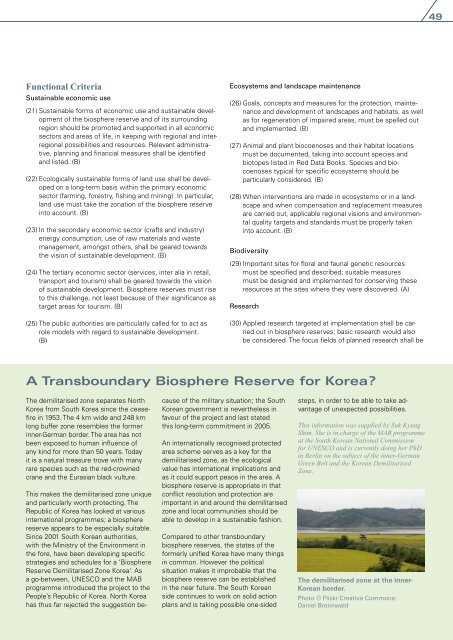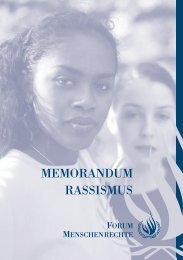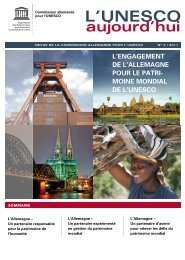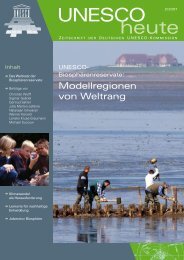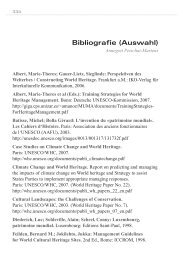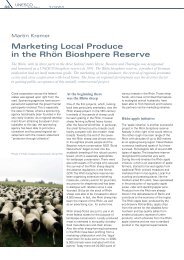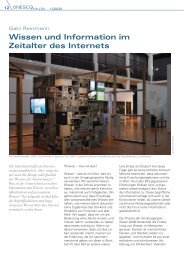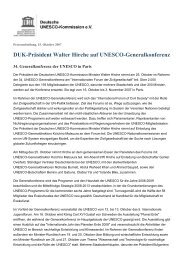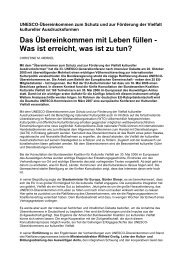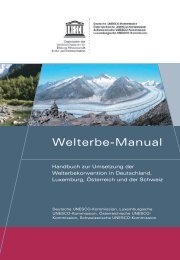Biosphere Reserves - UNESCO Deutschland
Biosphere Reserves - UNESCO Deutschland
Biosphere Reserves - UNESCO Deutschland
You also want an ePaper? Increase the reach of your titles
YUMPU automatically turns print PDFs into web optimized ePapers that Google loves.
Functional Criteria<br />
Sustainable economic use<br />
(21) Sustainable forms of economic use and sustainable devel-<br />
opment of the biosphere reserve and of its surrounding<br />
region should be promoted and supported in all economic<br />
sectors and areas of life, in keeping with regional and interregional<br />
possibilities and resources. Relevant administra-<br />
tive, planning and financial measures shall be identified<br />
and listed. (B)<br />
(22) Ecologically sustainable forms of land use shall be developed<br />
on a long-term basis within the primary economic<br />
sector (farming, forestry, fishing and mining). In particular,<br />
land use must take the zonation of the biosphere reserve<br />
into account. (B)<br />
(23) In the secondary economic sector (crafts and industry)<br />
energy consumption, use of raw materials and waste<br />
management, amongst others, shall be geared towards<br />
the vision of sustainable development. (B)<br />
(24) The tertiary economic sector (services, inter alia in retail,<br />
transport and tourism) shall be geared towards the vision<br />
of sustainable development. <strong>Biosphere</strong> reserves must rise<br />
to this challenge, not least because of their significance as<br />
target areas for tourism. (B)<br />
(25) The public authorities are particularly called for to act as<br />
role models with regard to sustainable development.<br />
(B)<br />
ecosystems and landscape maintenance<br />
(26) Goals, concepts and measures for the protection, maintenance<br />
and development of landscapes and habitats, as well<br />
as for regeneration of impaired areas, must be spelled out<br />
and implemented. (B)<br />
(27) Animal and plant biocoenoses and their habitat locations<br />
must be documented, taking into account species and<br />
biotopes listed in Red Data Books. Species and bio-<br />
coenoses typical for specific ecosystems should be<br />
particularly considered. (B)<br />
(28) When interventions are made in ecosystems or in a landscape<br />
and when compensation and replacement measures<br />
are carried out, applicable regional visions and environmental<br />
quality targets and standards must be properly taken<br />
into account. (B)<br />
Biodiversity<br />
(29) Important sites for floral and faunal genetic resources<br />
must be specified and described; suitable measures<br />
must be designed and implemented for conserving these<br />
resources at the sites where they were discovered. (A)<br />
Research<br />
(30) Applied research targeted at implementation shall be carried<br />
out in biosphere reserves; basic research would also<br />
be considered. The focus fields of planned research shall be<br />
A Transboundary <strong>Biosphere</strong> Reserve for Korea?<br />
The demilitarised zone separates North<br />
Korea from South Korea since the ceasefire<br />
in 1953. The 4 km wide and 248 km<br />
long buffer zone resembles the former<br />
inner-German border. The area has not<br />
been exposed to human influence of<br />
any kind for more than 50 years. Today<br />
it is a natural treasure trove with many<br />
rare species such as the red-crowned<br />
crane and the Eurasian black vulture.<br />
This makes the demilitarised zone unique<br />
and particularly worth protecting. The<br />
Republic of Korea has looked at various<br />
international programmes; a biosphere<br />
reserve appears to be especially suitable.<br />
Since 2001 South Korean authorities,<br />
with the Ministry of the Environment in<br />
the fore, have been developing specific<br />
strategies and schedules for a ‘<strong>Biosphere</strong><br />
Reserve Demilitarised Zone Korea’. As<br />
a go-between, <strong>UNESCO</strong> and the MAB<br />
programme introduced the project to the<br />
People’s Republic of Korea. North Korea<br />
has thus far rejected the suggestion be-<br />
cause of the military situation; the South<br />
Korean government is nevertheless in<br />
favour of the project and last stated<br />
this long-term commitment in 2005.<br />
An internationally recognised protected<br />
area scheme serves as a key for the<br />
demilitarised zone, as the ecological<br />
value has international implications and<br />
as it could support peace in the area. A<br />
biosphere reserve is appropriate in that<br />
conflict resolution and protection are<br />
important in and around the demilitarised<br />
zone and local communities should be<br />
able to develop in a sustainable fashion.<br />
Compared to other transboundary<br />
biosphere reserves, the states of the<br />
formerly unified Korea have many things<br />
in common. However the political<br />
situation makes it improbable that the<br />
biosphere reserve can be established<br />
in the near future. The South Korean<br />
side continues to work on solid action<br />
plans and is taking possible one-sided<br />
steps, in order to be able to take advantage<br />
of unexpected possibilities.<br />
This information was supplied by Suk Kyung<br />
Shim. She is in charge of the MAB programme<br />
at the South Korean National Commission<br />
for <strong>UNESCO</strong> and is currently doing her PhD<br />
in Berlin on the subject of the inner-German<br />
Green Belt and the Korean Demilitarised<br />
Zone.<br />
The demilitarised zone at the inner-<br />
Korean border.<br />
Photo © flickr Creative Commons:<br />
Daniel Brennwald


